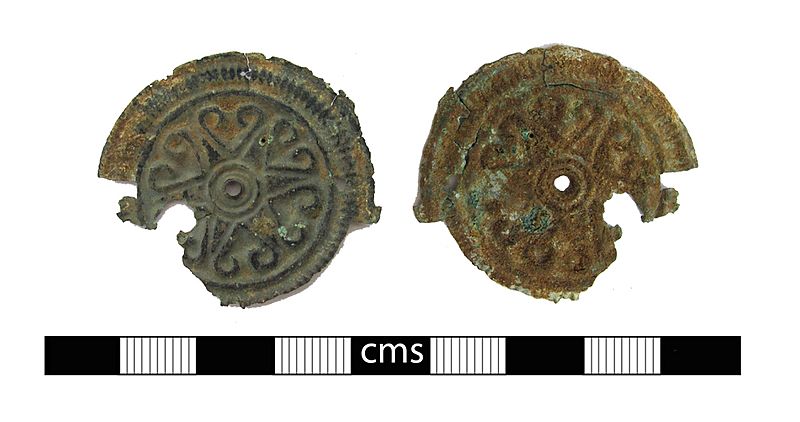Image: Early-medieval Brooch, Applied disc brooch (FindID 734477)

Description: This find represents part of an early Anglo-Saxon applied saucer brooch (also sometimes simply called an applied brooch), comprising the applied decorative copper alloy foil only. The foil is thin and circular, but has suffered some damage and is now missing approximately half of the outer edge and some of the central element. A complex repeating pattern has been hammered on to the reverse of the foil, resulting in an embossed design on the front (repoussé). The design comprises a central circular ring, within which a central hole is located. Around the circular ring are six chevrons, open heart-like designs with inward-scrolled terminals termed the floriate cross design (Prof. H. Hamerow, pers. comm.). Between each floriate element is a solid isosceles triangle. A second circumferential border separates this central design from the outer rim, which has been decorated with repeating short vertical lines arranged around the circumference of the foil. The reverse of the foil is indented with the design. No remains of the solder used to attach the foil to the backplate of the brooch remains. From the photograph, the diameter appears to be c. 36-37mm. Several applied brooches have been recorded on this database but this is the first example of a single foil sheet recorded. Due to the fragility of applied brooches, it is usually the case that the more solid backplate survives, sometimes with elements of the foil still attached but, as is the case with examples on this database, often missing the decorative foil altogether. There are 40 or so examples in the Ashmolean Museum illustrated by MacGregor and Bolick (1993:32-41), including foil-only elements. An applied disc brooch from Minchin Recreation Ground in Dorchester (MacGregor and Bolick 1993, no. 1.5) was found only a few hundred metres from the findspot of this example. However the decorative features of that brooch are not similar to the one recorded here, indeed of those illustrated by MacGregor and Bolick, only one bears similar decoration; no. 1.18, from an inhumation in Harwell, Oxon, also displays the heart-shaped motifs but combined with other decorative elements. An example from an inhumation at Long Wittenham, across the Thames from Dorchester, has a cruciform design with paired scrolled terminals (Evison 1978 Pl. LVa) similar to the heart-shaped motif on the new Dorchester example. With regards to dating, applied brooches developed in the late fourth century AD in northern Germany. They are found in the area between the Rivers Elbe and Weser (MacGregor and Bolick 1993:32), the traditional homelands of the Saxons. The Minchin Recreation Ground brooches specifically are thought to be the earliest examples in England, dating to the beginning of the fifth century AD (MacGregor and Bolick 1993, 32 and 34, no. 1.5). A die stamp with similar decoration but apparently only five cross-arms (or heart shapes) has recently been recorded at BERK-27A491.
Title: Early-medieval Brooch: Applied disc brooch
Credit: https://finds.org.uk/database/ajax/download/id/526929 Catalog: https://finds.org.uk/database/images/image/id/526929/recordtype/artefacts archive copy Artefact: https://finds.org.uk/database/artefacts/record/id/734477
Author: Oxfordshire County Council, Anni Byard, 2015-07-31 11:34:05
Permission: Attribution License version 2.0 (verified 29 November 2020)
Usage Terms: Creative Commons Attribution 2.0
License: CC BY 2.0
License Link: https://creativecommons.org/licenses/by/2.0
Attribution Required?: Yes
Image usage
The following page links to this image:

